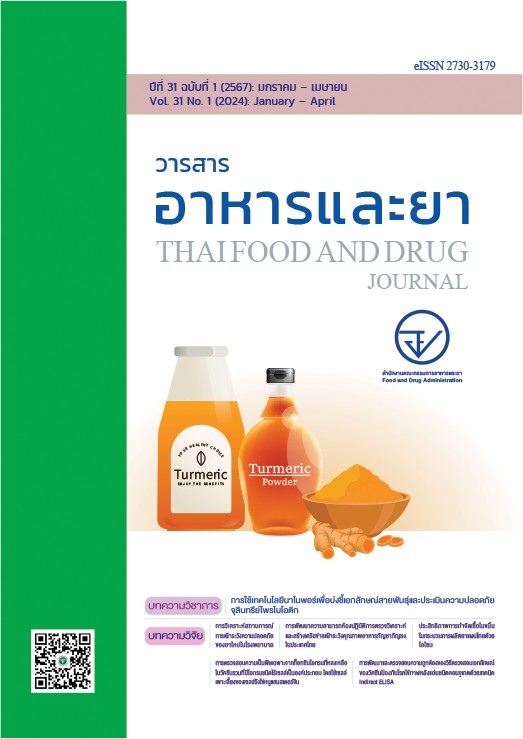การพัฒนาและตรวจสอบความถูกต้องของวิธีตรวจสอบเอกลักษณ์ของวัคซีนป้องกันโรคไข้กาฬหลังแอ่นชนิดคอนจูเกตด้วยเทคนิค Indirect ELISA
Main Article Content
บทคัดย่อ
ความสำคัญ: การตรวจสอบเอกลักษณ์ของวัคซีนป้องกันโรคไข้กาฬหลังแอ่น เป็นรายการทดสอบหนึ่งที่มีความสำคัญในการควบคุมคุณภาพวัคซีน เพื่อยืนยันว่าวัคซีนประกอบด้วยโพลีแซคคาไรด์ของเชื้อแบคทีเรีย Neisseria meningitidis แต่ละซีโรกรุ๊ปเชื่อมต่อกับท็อกซอยด์เชื้อคอตีบที่ใช้เป็นโปรตีนพาหะ ตรงตามซีโรกรุ๊ปที่ระบุในทะเบียนตำรับยาชีววัตถุ เพื่อสร้างความมั่นใจในคุณภาพของวัคซีนตามมาตรฐานของผลิตภัณฑ์ ดังนั้นหน่วยงานได้ขยายขีดความสามารถในการตรวจสอบเอกลักษณ์ของวัคซีนป้องกันโรคไข้กาฬหลังแอ่น ซึ่งเป็นรายการทดสอบที่ยังไม่เคยให้บริการมาก่อนสำหรับการตรวจควบคุมคุณภาพวัคซีนป้องกันโรคไข้กาฬหลังแอ่นชนิดคอนจูเกต
วัตถุประสงค์: เพื่อศึกษาสภาวะที่เหมาะสม และตรวจสอบความถูกต้องของวิธีตรวจสอบเอกลักษณ์ของวัคซีนป้องกันโรคไข้กาฬหลังแอ่นชนิดคอนจูเกต เพื่อนำมาใช้เป็นวิธีมาตรฐานทางห้องปฏิบัติการในการตรวจยืนยันเอกลักษณ์ของวัคซีนป้องกันโรคไข้กาฬหลังแอ่นชนิดคอนจูเกต
วิธีการวิจัย: การศึกษาสภาวะที่เหมาะสมของวิธีด้วยการศึกษาปฏิกิริยาจำเพาะระหว่างแอนติเจนและแอนติบอดี และศึกษาการตรวจสอบความถูกต้องของวิธีในพารามิเตอร์ หัวข้อความจำเพาะ และความเที่ยงของวิธีวิเคราะห์
ผลการศึกษา: การศึกษาสภาวะที่เหมาะสมของวิธีตรวจสอบเอกลักษณ์ของวัคซีนป้องกันโรคไข้กาฬหลังแอ่นชนิดคอนจูเกตด้วยเทคนิค Indirect ELISA พบว่าระดับการเจือจางความเข้มข้นของแอนติบอดีที่เหมาะสมต่อการทดสอบสำหรับแอนติเจนแต่ละชนิดแตกต่างกัน โดยสารแอนติบอดี N. meningitidis antiserum group A เตรียมที่ระดับเจือจางความเข้มข้น 1:10,000 ในขณะที่แอนติบอดี N. meningitidis antiserum group C, Y และ W135 เตรียมที่ระดับเจือจางความเข้มข้น 1:5,000 ตามลำดับ และวิธีการทดสอบนี้ต้องทำการทดสอบตามแม่แบบของเพลททดสอบที่กำหนดไว้ จึงสามารถตรวจวิเคราะห์เอกลักษณ์ของวัคซีนได้อย่างถูกต้อง เนื่องจากแอนติเจนแต่ละชนิดมีความจำเพาะต่อแอนติบอดี และผลการศึกษาความถูกต้องของวิธีนี้ พบว่าวิธีมีความจำเพาะสูง โดยคำนวณจากค่า Ratio ของแอนติเจนแต่ละชนิด ซึ่งมีค่า Ratio อยู่ในช่วง 17.69 – 40.78 ในขณะที่หากไม่เกิดปฏิกิริยาจำเพาะระหว่างแอนติเจนและแอนติบอดี ค่า Ratio มีค่าน้อยมากอยู่ในช่วง -0.02 – 4.95 จึงสามารถระบุเอกลักษณ์ของแอนติเจนแต่ละชนิดได้อย่างจำเพาะ โดยไม่มีการเกิด cross reaction ข้ามซีโรกรุ๊ปกัน และค่า OD450 nm ของ blank ในเพลททดสอบมีค่าน้อยกว่า 0.1 ซึ่งเป็นไปตามเกณฑ์ที่กำหนด และผลการศึกษาความเที่ยงของวิธี โดยผู้วิเคราะห์ 2 คน ที่เป็นอิสระต่อกัน พบว่าผลการทดสอบทั้ง 2 คนเป็นไปตามเกณฑ์ที่กำหนด และค่าเฉลี่ย Ratio ของสารมาตรฐานและตัวอย่างวัคซีนจากการทดสอบของนักวิเคราะห์ทั้ง 2 คน ไมแตกตางกันอยางมีนัยสําคัญที่ระดับความเชื่อมั่น 95%
สรุป: การศึกษานี้พบว่าวิธีตรวจสอบเอกลักษณ์ของวัคซีนป้องกันโรคไข้กาฬหลังแอ่นชนิดคอนจูเกตด้วยเทคนิค Indirect ELISA ผ่านการตรวจสอบความถูกต้องของวิธี ซึ่งเป็นไปตามเกณฑ์กำหนด ดังนั้นวิธีนี้จึงมีความเหมาะสมสำหรับนำวิธีมาใช้เป็นวิธีมาตรฐานทางห้องปฏิบัติการ เพื่อใช้ประกอบการขอขึ้นทะเบียนตำรับยาชีววัตถุจำหน่ายในประเทศ
Article Details

อนุญาตภายใต้เงื่อนไข Creative Commons Attribution 4.0 International License.
เอกสารอ้างอิง
Mahmoud FM, Harhara T. Neisseria meningitidis pneumonia with bacteremia without meningitis: An atypical presentation. IDCases 2020; 21:e00897: 1-3.
กรมควบคุมโรค กระทรวงสาธารณสุข. ตําราวัคซีนและการสร้างเสริมภูมิคุ้มกันโรค: วัคซีนป้องกันโรคไข้กาฬหลังแอ่น. กรุงเทพฯ: เวิร์คพริ้นท์; 2562.
Centers for Disease Control and Prevention (CDC). Meningococcal Disease [Internet]. [cited 2023 Aug 21]; [6 screens]. Available from: https://wwwnc.cdc.gov/travel/yellowbook/ 2024/infections-diseases/meningococcal-disease
World Health Organization. Annex 2 Recommendations to assure the quality, safety and efficacy of group A meningococcal conjugate vaccines. Technical Report Series No. 962, Geneva; 2011. p. 134–7.
International Conference on Harmonization of Technical Requirements for Registration of Pharmaceuticals for Human Use (ICH). Validation of Analytical Procedures: Text and Methodology Q2(R1) [Internet]. 2005; [cited 2022 Jun 18]; [17 screens]. Available from: https://www.gmp-compliance.org/files/guidemgr/Q2(R1).pdf
Sharma N, Hanif S, Upadhyay D, Chhikara MK. Inhibition ELISA as a putative tool for the identification and quantification of meningococcal A and X polysaccharides at various stages of vaccine development. J. Immunol Methods 2019; 493: 1-7.
Dell EJ. Optical Density for Absorbance Measurements [Internet]. BMG LABTECH; 2021 Oct 22- [cited 2022 Apr 7]. Available from: https://www.bmglabtech.com/en/blog/ optical-density-for-absorbance-assays/
World Health Organization. Training manual for Enzyme linked immunosorbent assay for the quantitation of Streptococcus pneumoniae serotype specific IgG (Pn PS ELISA) (007sp Version). Birmingham, AL, University of Alabama [Internet]. 2010; [cited 2022 May 18]; [29 screens]. Available from: https://www.vaccine.uab.edu/uploads/mdocs/ELISAProtocol (007sp).pdf
Harrison OB, Claus H, Jiang Y, Bennett JS, Bratcher HB, Jolley KA, et al. Description and nomenclature of Neisseria meningitidis capsule locus. Emerg Infect Dis [Internet]. 2013. [cited 2023 Oct 12]. Available from: http://dx.doi.org/10.3201/eid1904.111799
Spinosa MR, Progida C, Tala A, Cogli L, Alifano P, Bucci C. The Neisseria meningitidis Capsule Is Important for Intracellular Survival in Human Cells. Infect Immun 2007; 75(7): 3594-603.


